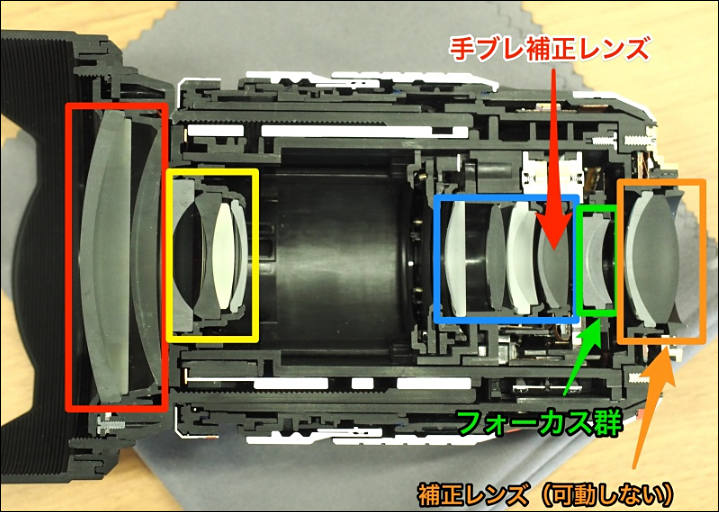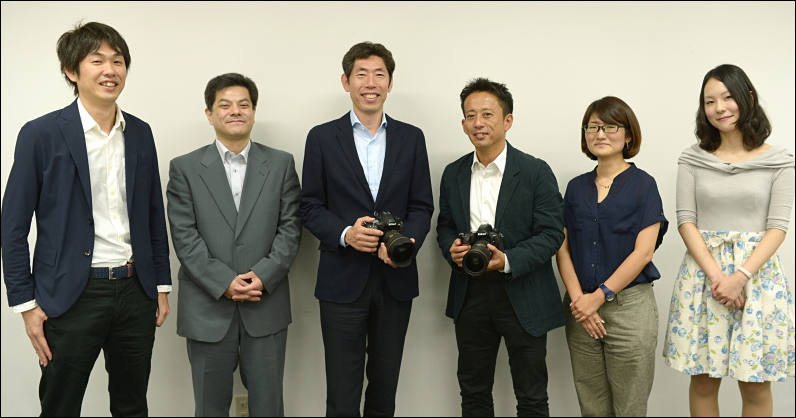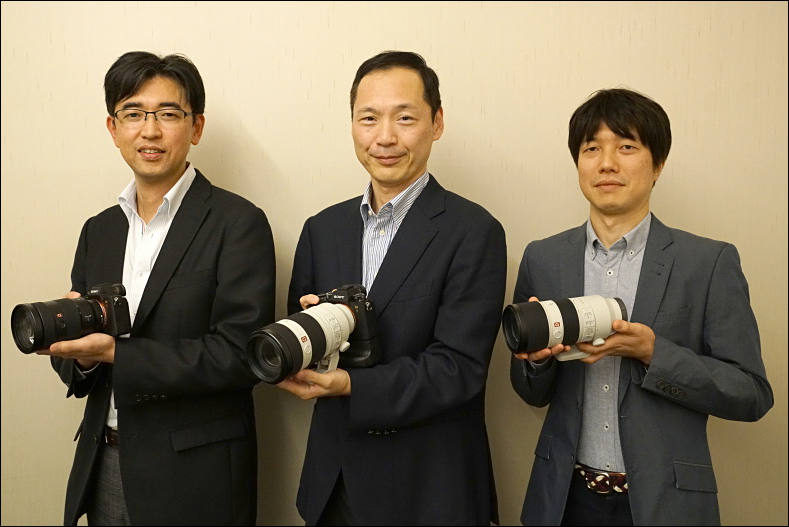
It allows to keep PV going, with more focus towards AI, but keeping be one of the few truly independent places.
-
Interview in Japanese about 12-100mm lens

http://dc.watch.impress.co.jp/docs/news/interview/1053285.html

 sample1169.jpg719 x 512 - 77K
sample1169.jpg719 x 512 - 77K -
Sony interview
Is 8K video something you're already working on?
KT: We can't comment on future product plans; however, we can confirm that we are paying close attention to all trends in the video marketplace, including 8K.
And you already have products that are sampling 6K: the a6500 oversamples its 4K footage by 2.4-fold yielding extremely crisp footage. Meanwhile we have some professional videographers intent on using high-end pro- 6K and 8K products to get oversampled 4K; yet you offer it in a consumer product. I find that interesting.
KT: Yes, we already have 6K sampling.
Are you also focusing on global shutter?
KT: Yes, that is one technique to remove rolling shutter artifacts. However, there are other choices to remove this artifact, like a mechanical shutter.
-
Panasonic interview
‘After we introduced the GH4, which was the world’s first 4K mirrorless camera, this 4K technology has been applied in models like G7, G8 and LX100. For the development roadmap, the new technology will first appear in the flagship and then, looking at price and value for money, we will expand the range.’
‘Towards the year 2020, 4K will evolve to 8K. Panasonic has supported the Olympic Games for a long time and in 2020, when the games are in Tokyo, the era of 8K will start, [and] we will develop the hardware to develop the 8K picture.’
As far as for the customer category, we don’t know if we will be able to record all of the output from 8K video. So the question is how we utilize 8K information and create a new photographic culture’
-
Sigma CEO Kazuto Yamaki interview
-
Sony and APS-C
In a panel discussion between the four press members and an all-star executive and engineering panel from Sony, we were all a little surprised by how shocked they seemed to be when we said that there was a widespread perception in the US that Sony was backing away from APS-C. While we felt we saw a lot of evidence of this, and in fact had heard Sony themselves talking about how they felt full-frame was the future and a major focus of theirs, the execs seemed genuinely shocked that anyone might have been thinking this.
After some back and forth in the conversation, we received a very direct statement from Kenji Tanaka, Senior General Manager, Business Unit 1, Digital Imaging Group. (That's a typical Japanese business title, but the bottom line is that Tanaka-san is the person in charge of all of Sony's interchangeable-lens camera development.)
Tanaka-san was very emphatic. Paraphrasing slightly, he said "APS-C is an important category for us. We'll never quit APS-C!"
http://www.imaging-resource.com/news/2017/08/10/sony-says-clearly-aps-c-forever
-
Sony believes that it is in a unique position to grow the imaging market. The communication between its image sensor development engineers at Sony Semiconductor and the camera teams at Sony DI give the company a unique advantage: an understanding of important sensor technologies to come two, five, or ten years down the line. The two-way communication between a cutting-edge sensor foundry and camera engineers that need sensor technologies to solve photographic problems is a unique advantage for Sony's camera division. And Sony's sensor design and fab group must stay cutting edge simply due to the number of sectors it has its hands in: from smartphones to the medical industry.
https://www.dpreview.com/articles/9600049212/sony-vision-over-profit
-
Nikon interview mostly about DF and such
High MP has limits due to high ISO and dynamic range. Why the D4 sensor has resolution it has? Because its low MP allows excellent high ISO performance. If we were to increase MP to, say 24 to 30MP, I think it’s boring. If we use D5 sensor its high ISO is very good. Otherwise we may go for D850 sensor. There could be two versions, a D5 version and a D850 version to satisfy more users. However, fast shooting rate such as 10 fps won’t be there and I wouldn’t put video in there too. If we put all the features in the market today to DF successor, how does it differentiate from cameras in the market? When we designed Df back then we didn’t consider every potential user, only a few niche customers. So we throw away some unnecessary features.
D5 is designed by Nikon and made by other company obviously. Nikon customer base is very broad, from novice to enthusiasts to prosumer to professional, that’s Nikon’s advantage. Olympus, Sony and Fujifilm can only cover a small part of that. So far there is no professional using their products. So when they develop products, even like retro style, they only try to meet these people and that’s only what they can do. Their customer base is limited anyway so they have limited view in developing products. If we were to take everyone’s features to integrate to Nikon products like you suggested, Nikon would never do that. Of course we would consider good stuff, mostly things behind the back. Nikon would absolutely not consider overall view, design style, and function from others. Because Nikon has almost 60 year history of making cameras and we have been communicate with all kind of customers and listen to them. With such experience we are a level not those companies can be compared. If we were to introduce a mirrorless camera, we would not be like them, such as pushing out a lot of models. We will lock in customer’s main requirement to introduce a new product. If fact before A9 was introduced, Sony went through a lot failure internally. Nikon has a lot more failure experience than Sony.
-
Nikon D850 interview in Japanese
http://dc.watch.impress.co.jp/docs/news/interview/1081951.html
-
Another Sony interview
- Yutaka Iwatsuki - Product Planning (camera body),
- Yasufumi Machitani - Design Concept, Product Design Div. (camera body),
- Kazumi Kageyama - Image Sensor, Product Design Div. (camera body),
- Shingo Takabayashi - Autofocus, Software Technology Div. (camera body),
- Kouji Hisamatsu - Mechanical Design, Core Technology Div. (camera body),
- Mitsuhiro Suzaki - Product Planning (lenses),
- Tomoomi Ito - Lens Control, Core Technology Div (lenses).
https://www.optyczne.pl/597.1-artykuł-Wizyta_w_głównej_siedzibie_Sony_w_Tokio.html?19118
-
Interview with Nikon Image Business Division about D850

https://dc.watch.impress.co.jp/docs/news/interview/1085159.html
-
Dave made another interesting and long Sony interview
Dave Etchells: I'm curious too, how much the video products are separate, or are they also under your part of the organization?
Hiroyuki Matsushita: Digital imaging group and the Handycam for consumer video cameras are completely the same group. And we do have professional video camera group, which is also under SIPS, which is the same company.
Dave Etchells: Ah, Sony Imaging Products and Solutions, yeah.
Hiroyuki Matsushita: The final product is totally different but the basic technology is based on the same platform.
Hiroyuki Matsushita: One example is the super slow-motion function which is available now in the RX100 cameras. That technology's base is cascaded down from professional video.
Dave Etchells: Ah, interesting! I didn't realize that; so the very high frame-rate video came down from there.
Yasuyuki Nagata: Right.
Dave Etchells: A question about lenses, how different are the design criteria for video lenses as opposed to still image lenses? What differences are there in terms of the criteria or constraints?
Hiroyuki Matsushita: There's no criteria, basically… So for E-mount lenses, being our Alpha camera mount, meant that we would get a mix of professionals using it for video, but also lower-end consumers using it for stills. So from the initial stage of development we always think about the video function in tandem with still shooting, especially the way we think about how the actuator should move smoothly and silently. That’s the starting point. And the latest lenses also consider the feel of manual focusing.
Maybe some journalist like you or some professionals said that the first-stage lenses like APS-C 18-105mm, for example, is really good for video shooting with our Alpha 6500 or the like. But it isn't... honestly speaking it's not good for the feeling of the manual focus. But the current latest models we really consider the “feeling” of the manual.
Dave Etchells: Because professional videographers are pulling focus manually.
Hiroyuki Matsushita: Yes. So it means that basically all E-mount lenses always consider the video function, the video feeling, from the start. Furthermore, some lenses should highlight autofocus speed as really important, some lenses should maybe focus more on bokeh quality, etc.
http://www.imaging-resource.com/news/2017/11/13/sony-interview-photoplus-expo-mirrorless-strategy
-
Sony Interview about G master Lenses
Q So, whole concept of the G Master series is to be high image quality and beautiful bokeh lens?
Nagata: Yes. It is message easy for our customers to understand, it was our primal thought - "to achieve best resolution and blur". When I first asked Kanai (Mr. Masami, director of optical image design) at the beginning of development, I immediately heard that "resolution and blur are optically contradictory properties and it is difficult to make them compatible". I asked him to do the ultimate anyway though it was there. In conclusion, I believe that this really difficult task was truly achieved at the ultimate level.
In addition, not only optical performance, but also development of the current α 7 R III and α 9 was also known during development, so it is necessary to support high-speed AF focusing speed and AF operation for video tasks also. We are also focused on concept to firmly make the best things in every aspect, such as durability and robustness.
https://dc.watch.impress.co.jp/docs/news/interview/1094352.html
-
Canon Chairman and CEO Fujio Mitarai
Q: How do you see earnings performing for the current fiscal year ending December 2018?
A: 2017 was a strong year for cameras, office equipment and other existing businesses. With the addition of new business segments like health care and industrial equipment, we have evidently boosted both sales and profit.
The business climate will improve further in 2018, and we aim to lift sales and profit for a second consecutive year.
-
Interview with Sony G Master lenses developers

https://dc.watch.impress.co.jp/docs/news/interview/1098822.html

 sa1633.jpg789 x 527 - 53K
sa1633.jpg789 x 527 - 53K -
Pentax/Ricoh interview
-
Sony Interview
How long will it be before Canon and Nikon join Sony and mirrorless full-frame becomes the norm?
This is just my personal opinion, but I think that maybe by next year’s CP+ you’ll see full-frame mirrorless cameras from Canon and Nikon. I think [by then] they will be participating in this market.
-
Canon Interview
The move from FD to EF in 1987 was bold but also controversial given the legacy of FD lenses and the lack of compatibility between the two platforms. Do you think that situation will happen again?
That’s a difficult question to answer. There was a lot of discussion and debate about that shift, in 1987, and we’re going through the same thing now. We want to nurture and support our [existing] EF customers and we’re in discussion about that at the moment.
In 1987, the shift was from a mechanical interface to an electronic interface. That [precluded cross-compatibility]. Despite that shift, the change provided significantly more value for our customers, which is why we went ahead. If it turns out that [the introduction of mirrorless] will create a similar situation, this might be a decision that we would take [again]. But we’re not sure yet.
Because we’re already using an electronic interface, the shift will be more gradual [than it was in 1987] so [we would better able to] maintain compatibility.
-
Sigma CEO 3 part interview
- http://mizuwari.fr/index.php/2018/02/28/entretien-avec-kazuto-yamaki-le-pdg-le-plus-classe-du-monde-1-3/
- http://mizuwari.fr/index.php/2018/03/07/entretien-kazuto-yamaki-sigma-opticien-capteurs/
- http://mizuwari.fr/index.php/2018/03/16/entretien-avec-kazuto-yamaki-la-chine-et-le-futur-de-la-photographie-3-3/
-
Nikon interview
Nikon currently only uses optical stabilization. One of the problems of sensor stabilization, the sensor may no longer be exactly on the image plane of the camera and the image can lose precision. As we explained, we are not deploying new technology without being certain of its reliability and usefulness. Please wait, because we are developing this technology that will be used in the years to come.
It will be possible to make 100mpix sensor! Diffraction is governed by physical laws and this phenomenon can not be eliminated only with optical technologies. We consider that on this point, a numerical correction is effective. What is very important for Nikon is that the use of digital corrections is not governed by technical constraints on a goal, but only to mitigate phenomena that we can not optically avoid.
-
Tamron interview
This new lens is not in the ‘SP’ range. What does this signify?
Within Tamron, we have an internal definition of SP, where we usually utilize metal for the body material, and certain other features. Optical performance of the new 28-75mm F2.8 will be equivalent to our SP lenses, but for this model we prioritized smaller size and lower weight, so we used polycarbonate instead of metal.
-
Fujifilm interview
How well has the GFX 50S performed since it was released?
We’ve shipped more than we expected and planned for. Even more impressive is the lens attachment rate, as we’ve sold so many lenses as well. Overall, GFX sales have exceeded our predictions.
As far as customer feedback, we heard mostly good things concerning the image quality – especially for users that shoot landscapes that need more dynamic range compared to APS-C cameras. Something that we didn’t expect was the number of high-end amateurs buying the GFX system. According to our survey, 80% of users are non-professional, and 20% are professional. That was a surprise.
-
Sigma interview
If you had designed the recently-announced E-mount primes from the ground up for Sony’s full-frame cameras, would they be smaller?
The wide-angle lenses would be, yes. We just announced E-mount versions of the 14mm, 20mm, 24mm, 35mm, 50mm, 85mm and 135mm. Probably, the 14mm, 20mm and 24mm lenses could have been smaller [if they were designed for Sony full-frame from the beginning]. But any lens longer than 35mm, they’d be about the same size. Our 35mm F1.4, for example, is about the same size as the Sony 35mm F1.4. But for wider lenses, because of the short flange-back distance of the E-mount, we could make them smaller.
This is one of the reasons we decided on our approach with these lenses. Because the size difference would have been minimal with most of the focal lengths, we focused on making the performance better and smoother, using our existing optical designs.
https://www.dpreview.com/interviews/2150589362/sigma-interview-this-is-just-the-beginning
-
Olympus interview
You’re relatively new in your role as head of the imaging business unit. How will your leadership change the company?
We’ve gone through a painful period, in the past. We had to shrink the size of the business, and that was reflected in our product lineup - especially the compact cameras. But now it’s time to enhance [and grow] the imaging business and catch up in terms of market share. Part of this will be enhancing our lineup.
How long have you been with Olympus?
I joined Olympus 32 years ago, initially in the accounting department. I’ve been with the imaging division for ten years. In 1997-2002 I worked in Hong Kong, where I established our factory in China.
https://www.dpreview.com/interviews/2809335911/cp-olympus-interview
Howdy, Stranger!
It looks like you're new here. If you want to get involved, click one of these buttons!
Categories
- Topics List23,997
- Blog5,725
- General and News1,359
- Hacks and Patches1,153
- ↳ Top Settings33
- ↳ Beginners256
- ↳ Archives402
- ↳ Hacks News and Development56
- Cameras2,367
- ↳ Panasonic995
- ↳ Canon118
- ↳ Sony156
- ↳ Nikon96
- ↳ Pentax and Samsung70
- ↳ Olympus and Fujifilm101
- ↳ Compacts and Camcorders300
- ↳ Smartphones for video97
- ↳ Pro Video Cameras191
- ↳ BlackMagic and other raw cameras116
- Skill1,960
- ↳ Business and distribution66
- ↳ Preparation, scripts and legal38
- ↳ Art149
- ↳ Import, Convert, Exporting291
- ↳ Editors191
- ↳ Effects and stunts115
- ↳ Color grading197
- ↳ Sound and Music280
- ↳ Lighting96
- ↳ Software and storage tips266
- Gear5,420
- ↳ Filters, Adapters, Matte boxes344
- ↳ Lenses1,582
- ↳ Follow focus and gears93
- ↳ Sound499
- ↳ Lighting gear314
- ↳ Camera movement230
- ↳ Gimbals and copters302
- ↳ Rigs and related stuff273
- ↳ Power solutions83
- ↳ Monitors and viewfinders340
- ↳ Tripods and fluid heads139
- ↳ Storage286
- ↳ Computers and studio gear560
- ↳ VR and 3D248
- Showcase1,859
- Marketplace2,834
- Offtopic1,320





